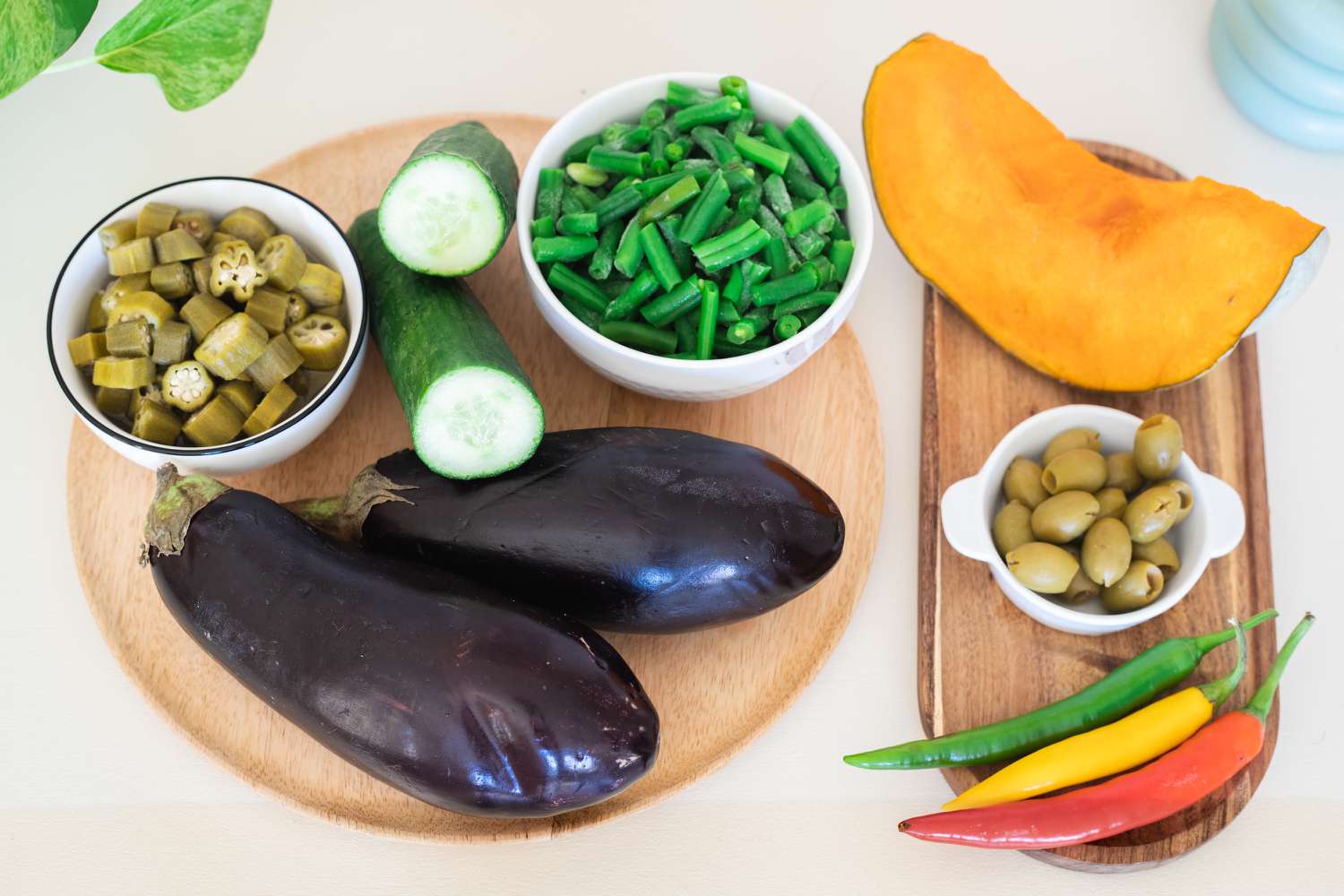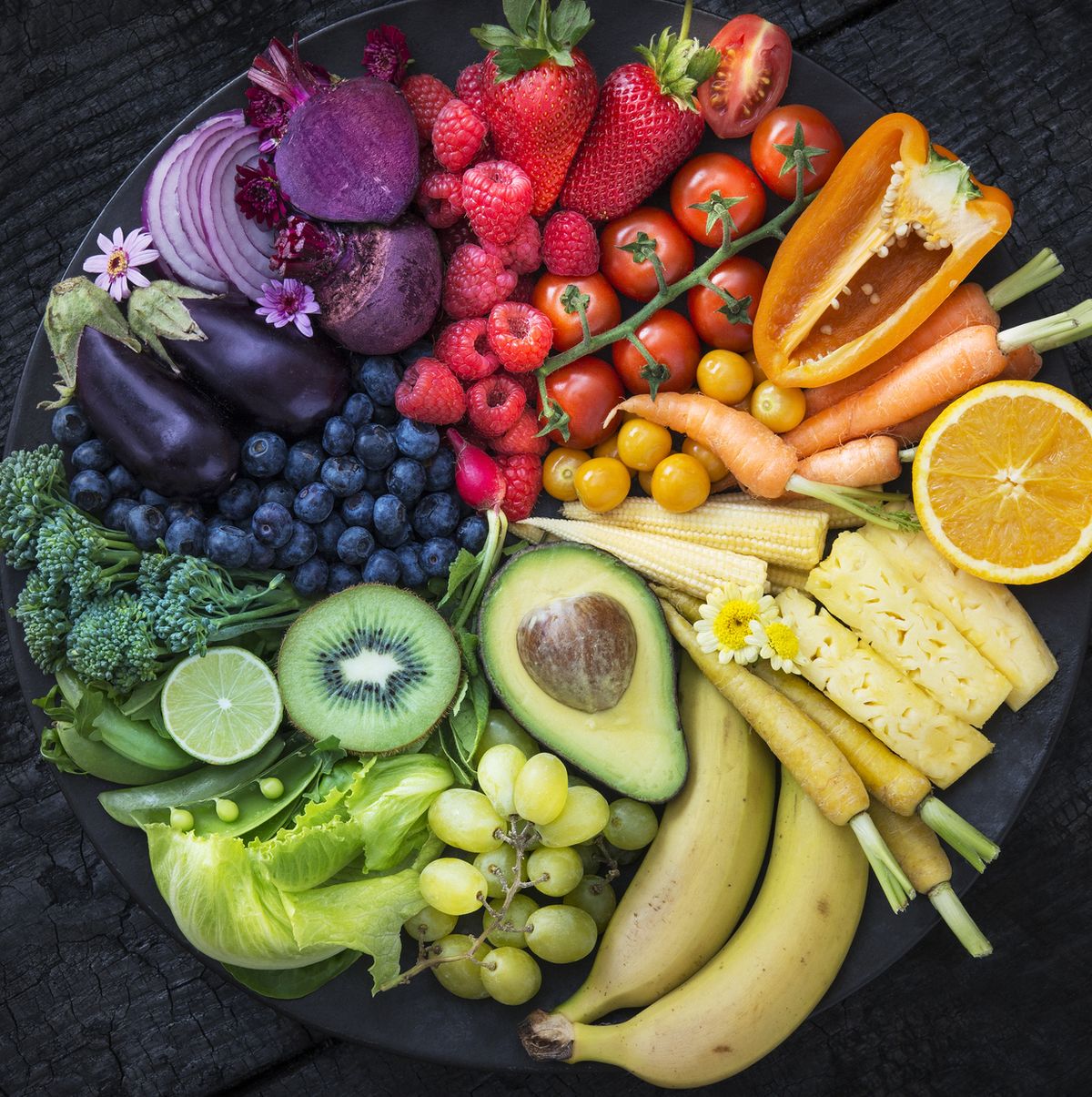Home>Gardening News and Trends>Latest News>How To Get More Fruit And Vegetables In Your Diet


Latest News
How To Get More Fruit And Vegetables In Your Diet
Modified: January 22, 2024
Discover the latest news on how to incorporate more fruits and vegetables into your daily diet for a healthier lifestyle.
(Many of the links in this article redirect to a specific reviewed product. Your purchase of these products through affiliate links helps to generate commission for Chicagolandgardening.com, at no extra cost. Learn more)
Table of Contents
- Introduction
- Benefits of Eating More Fruit and Vegetables
- Understanding Daily Fruit and Vegetable Recommendations
- Tips for Incorporating More Fruit and Vegetables into Your Diet
- Meal Planning with Fruit and Vegetables
- Creative Ways to Increase Fruit and Vegetable Intake
- Overcoming Barriers to Eating More Fruit and Vegetables
- Conclusion
Introduction
Eating a diet rich in fruits and vegetables is essential for maintaining good health. These natural powerhouses are loaded with essential vitamins, minerals, fiber, and antioxidants that support proper functioning of the body and can help prevent chronic diseases such as heart disease, cancer, and obesity.
Despite their many benefits, most people struggle to consume the recommended daily servings of fruits and vegetables. Busy schedules, limited access to fresh produce, and lack of knowledge on how to prepare and incorporate them into meals often contribute to this challenge.
In this article, we will explore the numerous benefits of including more fruits and vegetables in your diet, delve into the recommended daily servings, and provide practical tips and creative ideas on how to incorporate these foods into your meals. Whether you’re a picky eater, have a hectic lifestyle, or are simply looking to improve your overall health, this article will help you find enjoyable and effortless ways to increase your fruit and vegetable intake.
Benefits of Eating More Fruit and Vegetables
Eating a diet rich in fruits and vegetables offers a plethora of health benefits. These colorful and nutrient-dense foods play a crucial role in promoting overall well-being and reducing the risk of various chronic diseases. Let’s explore some of the key benefits:
- Nutrient Powerhouses: Fruits and vegetables are packed with essential vitamins and minerals that are vital for maintaining optimal health. They are excellent sources of vitamins A, C, and E, as well as folate, potassium, and fiber.
- Weight Management: Fruits and vegetables are low in calories and high in fiber, which helps promote satiety and prevent overeating. They are also naturally low in fat, making them a great option for weight management.
- Heart Health: Many fruits and vegetables are rich in heart-healthy nutrients, such as antioxidants and dietary fiber. Consuming a variety of these foods can help lower blood pressure, reduce LDL (bad) cholesterol levels, and decrease the risk of heart disease.
- Cancer Prevention: Research suggests that a diet rich in fruits and vegetables may help reduce the risk of certain types of cancer. The antioxidants and phytochemicals found in these foods have been shown to protect against free radicals and inflammation, which are linked to the development of cancer cells.
- Improved Digestion: Fruits and vegetables are high in fiber, which promotes healthy digestion and prevents constipation. The fiber also acts as a prebiotic, nourishing the beneficial bacteria in the gut and supporting a healthy digestive system.
- Enhanced Immunity: Fruits and vegetables are an excellent source of vitamin C, which plays a key role in supporting a healthy immune system. Regular consumption of these foods can help strengthen your body’s defense mechanisms and protect against illnesses and infections.
- Healthy Aging: The antioxidants in fruits and vegetables help combat oxidative stress and protect against cellular damage, which can contribute to the aging process. By including more of these foods in your diet, you can promote healthy aging and maintain youthful skin.
As you can see, incorporating more fruits and vegetables into your daily meals can have a profound impact on your overall health. From providing essential nutrients to reducing the risk of chronic diseases, these nutrient powerhouses should play a central role in your diet. Now, let’s dive into understanding the daily fruit and vegetable recommendations to ensure you’re getting the right amount.
Understanding Daily Fruit and Vegetable Recommendations
Eating a sufficient amount of fruits and vegetables is essential for obtaining optimal health benefits. However, many individuals may not be aware of the recommended daily servings. The guidelines provided by health organizations can serve as a helpful reference to ensure you’re meeting your fruit and vegetable intake requirements.
The U.S. Department of Agriculture (USDA) recommends that adults consume 2 to 3 cups of vegetables and 1.5 to 2 cups of fruits per day. These recommendations may vary depending on factors such as age, sex, and level of physical activity. It’s important to note that these guidelines include a variety of fruits and vegetables, as different types offer different nutritional benefits.
When it comes to serving sizes, it can be helpful to visualize what constitutes a cup of fruits or vegetables. Here are a few examples:
- A medium-sized apple or banana
- Two small kiwis or plums
- A cup of grapes or berries
- A large carrot or a handful of baby carrots
- Two cups of leafy greens, such as spinach or lettuce
- A medium-sized bell pepper
Remember that these are general guidelines, and individual needs may vary. It’s important to consult with a healthcare professional or a registered dietitian to determine the specific daily fruit and vegetable servings that are suitable for you.
By understanding these recommendations, you can better gauge your own fruit and vegetable consumption and make necessary adjustments to ensure you’re meeting your nutritional needs. In the next section, we will provide practical tips on how to incorporate more fruits and vegetables into your daily meals.
Tips for Incorporating More Fruit and Vegetables into Your Diet
Incorporating more fruits and vegetables into your diet doesn’t have to be complicated or time-consuming. With a few simple tips and tricks, you can easily increase your intake of these nutritious foods. Here are some practical ideas to help you get started:
- Start the Day with Fruit: Add sliced berries or a banana to your cereal or yogurt in the morning. You can also blend fruits into a smoothie for a quick and convenient breakfast option.
- Snack on Fresh Produce: Keep a bowl of washed and cut-up fruits or vegetables on your kitchen counter or in the fridge for easy access. Reach for these nutritious snacks when hunger strikes during the day.
- Experiment with Salads: Incorporate a variety of colorful vegetables into your salads. Add leafy greens, cherry tomatoes, cucumbers, bell peppers, and any other vegetables that you enjoy. Be adventurous with your choice of salad dressings to enhance flavors.
- Make Fruit the Star of Desserts: Replace high-sugar desserts with naturally sweet options like baked apples, grilled peaches, or a fruit salad. Get creative and try new fruit combinations to satisfy your sweet tooth.
- Add Veggies to Your Main Dishes: Incorporate vegetables into your main meals by adding them to stir-fries, pasta dishes, casseroles, soups, or wraps. Opt for colorful options like broccoli, spinach, carrots, and bell peppers to make your dishes more visually appealing.
- Experiment with Veggie Noodles: Swap traditional pasta with vegetable noodles. Zucchini noodles, sweet potato noodles, or spaghetti squash can be a delicious and nutritious alternative to regular pasta.
- Make Smoothies: Blend a combination of fruits and vegetables into a delicious and refreshing smoothie. Try adding leafy greens like spinach or kale for an extra nutritional boost.
- Grill or Roast Vegetables: Grilling or roasting vegetables brings out their natural flavors and adds a delightful char. Toss them in olive oil, sprinkle with your favorite herbs and spices, and cook until tender.
- Experiment with Fruit and Vegetable Dips: Pair your favorite fruits and vegetables with tasty dips such as yogurt, hummus, or nut butter. This can make snacks more enjoyable and encourage you to eat more of them.
Remember, it’s important to prioritize variety and choose a wide range of fruits and vegetables to ensure you’re getting a diverse array of nutrients. Experiment with different cooking methods, flavors, and combinations to keep things interesting and enjoyable. Now that you have practical tips for incorporating more fruits and vegetables, let’s move on to meal planning with these nutrient-packed foods.
Meal Planning with Fruit and Vegetables
Meal planning is a great way to ensure that you’re incorporating more fruits and vegetables into your diet consistently. By intentionally including these foods in your meal plans, you can make healthier choices and maintain a balanced and nutritious diet. Here are some tips for meal planning with fruit and vegetables:
- Plan Ahead: Set aside some time each week to plan your meals and snacks. Consider the fruits and vegetables you have on hand or ones you’d like to try, and incorporate them into your meal ideas.
- Balance your Plates: Aim to fill half of your plate with vegetables for lunch and dinner. Include a mix of cooked and raw options to add variety and different textures to your meals.
- Prep in Advance: Take some time to chop, wash, and store your fruits and vegetables in portion-controlled containers. Having them easily accessible and ready to use will make it more likely that you’ll reach for them when preparing meals or snacks.
- Try Batch Cooking: Prepare large batches of roasted or grilled vegetables, soups, or stir-fries that can be portioned out and enjoyed throughout the week. This saves time and ensures that you have healthy options readily available.
- Experiment with New Recipes: Look for exciting recipes that feature fruits and vegetables as the star ingredients. Explore different cuisines and cooking techniques to keep your meals interesting and delicious.
- Use Fruits and Vegetables as Recipe Enhancers: Add fruits and vegetables as toppings or ingredients in your favorite dishes. For example, sprinkle berries on top of your oatmeal, mix diced tomatoes and peppers into your scrambled eggs, or add grated carrots and zucchini to your muffin batter.
- Make Smoothie Packs: Pre-portion fruits and vegetables for smoothies into individual bags or containers. This way, you can easily grab a pack and blend it with your choice of liquid for a quick and nutritious meal or snack.
- Freeze Fruits and Vegetables: If you have excess produce or want to stock up on seasonal fruits and vegetables, consider freezing them. This allows you to have them on hand for smoothies, soups, or stir-fries even when they’re out of season.
- Get Creative with Leftovers: Don’t let your leftovers go to waste. Use cooked vegetables in frittatas or omelets, blend them into soups, or toss them into salads for added texture and flavor.
By implementing these meal planning tips, you can ensure that you’re incorporating fruits and vegetables into your meals in a convenient and enjoyable way. Now, let’s explore some creative ideas to help you increase your fruit and vegetable intake even further.
Creative Ways to Increase Fruit and Vegetable Intake
Finding creative and fun ways to incorporate more fruits and vegetables into your diet can make the experience enjoyable and enticing. Here are some creative ideas to help you increase your fruit and vegetable intake:
- Power up Your Smoothies: Add a handful of spinach, kale, or other leafy greens to your fruit smoothies. The sweetness of the fruits will mask the taste of the greens, making it an easy and delicious way to boost your vegetable intake.
- Veggie-based Pasta Alternatives: Swap traditional pasta with vegetable alternatives like zucchini noodles, sweet potato noodles, or spaghetti squash. These low-carb options can help increase your vegetable intake while adding a burst of color to your plate.
- Grate and Mix: Grate vegetables like carrots, zucchini, or beets and mix them into your meatballs, burgers, or meatloaf. This not only adds moisture and flavor but also increases the nutritional value of the dish.
- Stuffed Vegetables: Get creative by stuffing vegetables such as bell peppers, zucchini, or tomatoes with a mixture of quinoa, lean protein, and spices. Baking or grilling them creates a delicious and nutritious meal.
- Wrap It Up: Use large lettuce leaves or collard green wraps as a substitute for tortillas or bread. Fill them with your favorite vegetables, protein, and sauce for a refreshing and nutritious wrap.
- Fruit and Vegetable Skewers: Thread bite-sized pieces of fruits and vegetables onto skewers for a colorful and fun snack or side dish. This is a great option for barbecues or gatherings.
- Homemade Veggie Chips: Slice vegetables like sweet potatoes, beets, or kale thinly and bake them in the oven until crisp. These homemade chips are a healthier alternative to store-bought snacks.
- Blend Vegetables into Sauces: Puree cooked vegetables like cauliflower, butternut squash, or carrots and mix them into pasta sauces, soups, or dips. This adds nutrition and creaminess without sacrificing flavor.
- Fruit-infused Water: Slice your favorite fruits and add them to a pitcher of water for a refreshing and flavorful beverage. Not only does this make water more enjoyable to drink, but it also infuses it with vitamins from the fruits.
- Make Fruit and Vegetable Popsicles: Blend fruits and vegetables together with some yogurt or coconut milk, pour the mixture into popsicle molds, and freeze. These homemade popsicles offer a healthy and refreshing treat.
By getting creative with how you incorporate fruits and vegetables into your meals and snacks, you can make the experience more exciting and enjoyable. Don’t be afraid to experiment with different combinations and techniques to find what works best for you. Now that we’ve explored various ways to increase your fruit and vegetable intake, let’s address some common barriers and how to overcome them.
Overcoming Barriers to Eating More Fruit and Vegetables
While many individuals understand the importance of eating more fruits and vegetables, there are common barriers that can hinder their consumption. By identifying these barriers and finding practical solutions, you can overcome them and increase your intake of these nutritious foods. Let’s explore some common barriers and strategies to overcome them:
- Lack of Accessibility: Limited access to fresh produce can make it challenging to incorporate fruits and vegetables into your diet. Look for local farmers’ markets, community-supported agriculture (CSA) programs, or consider growing your own herbs, fruits, or vegetables at home.
- Busy Lifestyle: A hectic schedule can make it difficult to prioritize healthy eating. Plan your meals in advance, utilize quick recipes, and prep fruits and vegetables ahead of time to make healthy options more convenient and accessible.
- Preference and Taste: If you’re not a fan of certain fruits or vegetables, explore different cooking methods and flavor combinations to find ways to enjoy them. Experiment with seasonings, spices, and different recipes to make them more appealing to your palate.
- Cost: Buying fruits and vegetables can sometimes be expensive. Look for seasonal produce, shop at local markets, and consider frozen options, as they can be more affordable while still providing essential nutrients.
- Lack of Knowledge and Skills: Not knowing how to prepare or cook fruits and vegetables can deter people from consuming them. Take advantage of online resources, cookbooks, and cooking classes to learn new techniques and recipes.
- Perceived Time and Effort: Some people may avoid fruits and vegetables because they believe they require a lot of time and effort to prepare. Opt for pre-cut and pre-washed options, incorporate raw vegetables into your meals, or use time-saving kitchen gadgets to make food preparation quicker and easier.
- Social and Peer Influence: Social situations can sometimes influence unhealthy food choices. Share your goals with friends and family, and encourage them to join you in incorporating more fruits and vegetables into their diets. Collaborate on meal ideas and potluck gatherings that focus on healthy, plant-based options.
- Outdated Traditions and Habits: Challenging traditional meals and habits can be difficult. Start by making small changes and gradually incorporating more fruits and vegetables into your favorite dishes. This allows you to maintain some familiarity while gradually expanding your repertoire.
- Stress and Emotional Eating: Stress and emotions can lead to unhealthy food choices. Find alternative ways to manage stress, such as exercise, meditation, or engaging in creative activities. When emotions trigger cravings, opt for healthier fruit or vegetable-based snacks instead of reaching for comfort foods.
By addressing these barriers and implementing strategies to overcome them, you can make it easier to incorporate more fruits and vegetables into your daily diet. Remember, small changes and consistent efforts can lead to significant improvements in your overall health and well-being.
Conclusion
Incorporating more fruits and vegetables into your diet is a powerful step towards a healthier lifestyle. These nutrient-dense foods offer a wide range of health benefits, from supporting proper functioning of the body to reducing the risk of chronic diseases. By understanding the daily fruit and vegetable recommendations, exploring practical tips for incorporating them into your meals, and getting creative with different preparation methods, you can increase your intake and enjoy a delicious and nutritious diet.
Meal planning with fruits and vegetables, experimenting with new recipes, and overcoming common barriers can help you make sustainable changes in your eating habits. Remember to prioritize variety, choose a rainbow of colors, and consider both fresh and frozen options to ensure a diverse and well-rounded intake of nutrients.
With a little creativity and a willingness to try new things, you can transform your relationship with fruits and vegetables and make them an integral part of your daily meals and snacks. Your body will thank you for the added vitamins, minerals, fiber, and antioxidants, and you will experience the benefits of improved energy, better digestion, enhanced immunity, and overall well-being.
So, challenge yourself to explore new flavors, experiment with different cooking techniques, and embrace the wonderful world of fruits and vegetables on your journey to a healthier, happier you.








